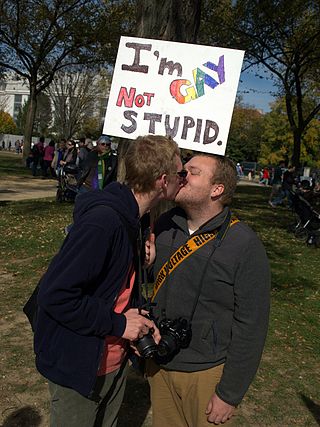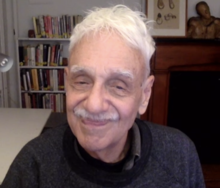
Lesbian, gay, bisexual, and transgender (LGBT) movements are social movements that advocate for LGBT people in society. Although there is not a primary or an overarching central organization that represents all LGBT people and their interests, numerous LGBT rights organizations are active worldwide. The first organization to promote LGBT rights was the Scientific-Humanitarian Committee, founded in 1897 in Berlin.

Heterosexuality is romantic attraction, sexual attraction or sexual behavior between people of the opposite sex or gender. As a sexual orientation, heterosexuality is "an enduring pattern of emotional, romantic, and/or sexual attractions" to people of the opposite sex; it "also refers to a person's sense of identity based on those attractions, related behaviors, and membership in a community of others who share those attractions." Someone who is heterosexual is commonly referred to as straight.

A lesbian is a homosexual woman or girl. The word is also used for women in relation to their sexual identity or sexual behavior, regardless of sexual orientation, or as an adjective to characterize or associate nouns with female homosexuality or same-sex attraction. The concept of "lesbian" to differentiate women with a shared sexual orientation evolved in the 20th century. Throughout history, women have not had the same freedom or independence as men to pursue homosexual relationships, but neither have they met the same harsh punishment as gay men in some societies. Instead, lesbian relationships have often been regarded as harmless, unless a participant attempts to assert privileges traditionally enjoyed by men. As a result, little in history was documented to give an accurate description of how female homosexuality was expressed. When early sexologists in the late 19th century began to categorize and describe homosexual behavior, hampered by a lack of knowledge about homosexuality or women's sexuality, they distinguished lesbians as women who did not adhere to female gender roles. They classified them as mentally ill—a designation which has been reversed since the late 20th century in the global scientific community.

Sexual orientation is an enduring personal pattern of romantic attraction or sexual attraction to persons of the opposite sex or gender, the same sex or gender, or to both sexes or more than one gender. Patterns are generally categorized under heterosexuality, homosexuality, and bisexuality, while asexuality is sometimes identified as the fourth category.
Queer studies, sexual diversity studies, or LGBT studies is the study of topics relating to sexual orientation and gender identity usually focusing on lesbian, gay, bisexual, transgender, gender dysphoric, asexual, queer, questioning, and intersex people and cultures.
Heteronormativity is the concept that heterosexuality is the preferred or normal sexual orientation. It assumes the gender binary and that sexual and marital relations are most fitting between people of opposite sex.

Societal attitudes toward homosexuality vary greatly across different cultures and historical periods, as do attitudes toward sexual desire, activity and relationships in general. All cultures have their own values regarding appropriate and inappropriate sexuality; some sanction same-sex love and sexuality, while others may disapprove of such activities in part. As with heterosexual behaviour, different sets of prescriptions and proscriptions may be given to individuals according to their gender, age, social status or social class.

Non-heterosexual is a word for a sexual orientation or sexual identity that is not heterosexual. The term helps define the "concept of what is the norm and how a particular group is different from that norm". Non-heterosexual is used in feminist and gender studies fields as well as general academic literature to help differentiate between sexual identities chosen, prescribed and simply assumed, with varying understanding of implications of those sexual identities. The term is similar to queer, though less politically charged and more clinical; queer generally refers to being non-normative and non-heterosexual. Some view the term as being contentious and pejorative as it "labels people against the perceived norm of heterosexuality, thus reinforcing heteronormativity". Still, others say non-heterosexual is the only term useful to maintaining coherence in research and suggest it "highlights a shortcoming in our language around sexual identity"; for instance, its use can enable bisexual erasure.

Terms used to describe homosexuality have gone through many changes since the emergence of the first terms in the mid-19th century. In English, some terms in widespread use have been sodomite, Achillean, Sapphic, Uranian, homophile, lesbian, gay, effeminate, queer, homoaffective, and same-gender attracted. Some of these words are specific to women, some to men, and some can be used of either. Gay people may also be identified under the umbrella term LGBT.

Homosexuality is a sexual attraction, romantic attraction, or sexual behavior between members of the same sex or gender. As a sexual orientation, homosexuality is "an enduring pattern of emotional, romantic, and/or sexual attractions" exclusively to people of the same sex or gender. It "also refers to a person's sense of identity based on those attractions, related behaviors, and membership in a community of others who share those attractions."
Sheila Jeffreys is a former professor of political science at the University of Melbourne, born in England. A lesbian feminist scholar, she analyses the history and politics of human sexuality.
Sexual inversion is a theory of homosexuality popular primarily in the late 19th and early 20th century. Sexual inversion was believed to be an inborn reversal of gender traits: male inverts were, to a greater or lesser degree, inclined to traditionally female pursuits and dress and vice versa. The sexologist Richard von Krafft-Ebing described female sexual inversion as "the masculine soul, heaving in the female bosom".
Feminist sexology is an offshoot of traditional studies of sexology that focuses on the intersectionality of sex and gender in relation to the sexual lives of women. Sexology has a basis in psychoanalysis, specifically Freudian theory, which played a big role in early sexology. This reactionary field of feminist sexology seeks to be inclusive of experiences of sexuality and break down the problematic ideas that have been expressed by sexology in the past. Feminist sexology shares many principles with the overarching field of sexology; in particular, it does not try to prescribe a certain path or "normality" for women's sexuality, but only observe and note the different and varied ways in which women express their sexuality. It is a young field, but one that is growing rapidly.

The questioning of one's sexual orientation, sexual identity, gender, or all three is a process of exploration by people who may be unsure, still exploring, or concerned about applying a social label to themselves for various reasons. The letter "Q" is sometimes added to the end of the acronym LGBT ; the "Q" can refer to either queer or questioning.

OutHistory.org is a website about lesbian, gay, bisexual, transgender, queer, and heterosexual history, and, more generally, gender and sexual history. OutHistory.org comprises elements of an almanac, archive, article, bibliography, book, encyclopedia, library, and museum.

The Homosexual Matrix is a book by American psychologist Clarence Arthur Tripp, in which the author discusses the biological and sociological implications of homosexuality, and also attempts to explain heterosexuality and bisexuality. The book was first published in 1975 by McGraw-Hill Book Company; it was republished in a revised edition in 1987. Based on his review of the evidence, Tripp argues that people do not become homosexual due to factors such as hormone levels, fear of the opposite sex, or the influence of dominant and close-binding mothers, and that the amount of attention fathers give to their sons has no effect on the development of homosexuality. He criticizes Sigmund Freud and argues that psychoanalytic theories of the development of homosexuality are untenable and based on false assumptions. He maintains that sexual orientation is not innate and depends on learning, that early puberty and early masturbation are important factors in the development of male homosexuality, and that a majority of adults are heterosexual because their socialization has made them want to be heterosexual. He criticizes psychotherapeutic attempts to convert homosexuals to heterosexuality and argues in favor of social tolerance of homosexuality and non-conformist behavior in general.

The following outline offers an overview and guide to LGBT topics.
Homonormativity is the adoption of heteronormative ideals and constructs onto LGBT culture and identity. It is predicated on the assumption that the norms and values of heterosexuality should be replicated and performed among homosexual people. Those who assert this theory claim homonormativity selectively privileges cisgendered homosexuality as worthy of social acceptance.

The history of bisexuality concerns the history of the bisexual sexual orientation. Ancient and medieval history of bisexuality, when the term did not exist as such, consists of anecdotes of sexual behaviour and relationships between people of the same and different sexes. A modern definition of bisexuality began to take shape in the mid-19th century within three interconnected domains of knowledge: biology, psychology and sexuality. In modern Western culture, the term bisexual was first defined in a binary approach as a person with romantic or sexual attraction to both men and women. The term bisexual is defined later in the 20th century as a person who is sexually and/or romantically attracted to both males and females, or as a person who is sexually and/or romantically attracted to people regardless of sex or gender identity, which is sometimes termed pansexuality.
The history of conversion therapy can be divided broadly into three periods: an early Freudian period; a period of mainstream approval of conversion therapy, when the mental health establishment became the "primary superintendent" of sexuality; and a post-Stonewall period where the mainstream medical profession disavowed conversion therapy.








